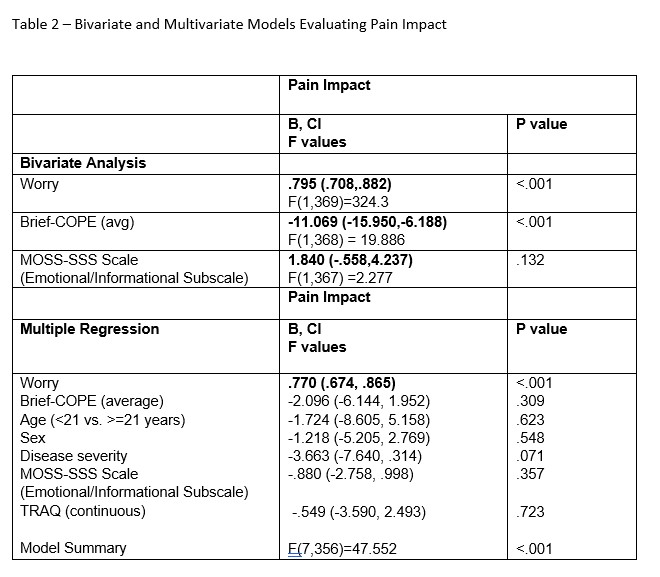Hematology/Oncology
Session: Hematology/Oncology
347 - Association of Disease Specific Worry on Pain Related Quality of Life in Young Adults with Sickle Cell Disease
Friday, May 3, 2024
5:15 PM - 7:15 PM ET
Poster Number: 347
Publication Number: 347.117
Publication Number: 347.117
- AI
Apoorva Iyengar, MD (she/her/hers)
Resident
Cohen Children's Medical Center
Manhasset, New York, United States
Presenting Author(s)
Background: Sickle Cell Disease (SCD) is an inherited hemoglobinopathy with multisystem complications including painful vaso-occlusive crisis. People with SCD usually have worse quality of life (QOL) than the general population. Previous studies in adults with SCD show that the impact of worry influences QOL related to pain.
Objective: This study evaluates the association between worry and pain related QOL in emerging adults with SCD as measured by worry and pain subscales from the Pediatric Quality of Life Inventory (PedsQL) Sickle Cell Disease Module, respectively. We also examined whether emotional social support and problem-based coping strategies moderate this association.
Design/Methods: This is a retrospective observational study on data collected between 1/2019-12/2022 from patients with SCD (ages 17 – 25) at 5 pediatric SCD centers in NY, PA, CT, and OH planning to transition to adult hematology within 12 months. Predictor was worry, as measured by the PedsQL Sickle Cell Module Worry 1 subscale. Outcome was pain, as measured by the PedsQL Sickle Cell Module Pain Impact subscale. We conducted multivariate regression assessing the effect of worry on pain, and moderating effects of social support – measured by MOS Social Support Survey Emotional/Informational Support subscale – and coping – measured by Brief-COPE, after adjustment for demographic and clinical characteristics, and transition readiness, measured by the Transition Readiness Assessment Questionnaire (TRAQ).
Results: The 373 participants were equally distributed by gender, largely non-Hispanic black by race/ethnicity, with 56% considered having severe sickle cell disease (Table 1). Worry was positively associated with pain in bivariate analysis (B .795, p <.001). In multivariate analysis, coping (P < 0.001) but not social support (P=0.132) moderated the relationship between worry and pain. After controlling for age, gender, disease severity, and transition readiness, worry was still significantly associated with pain (p <.001).
Conclusion(s): In this national cohort of adolescents and young adults with SCD, worry and coping are closely connected to pain-related QOL, suggesting that addressing disease specific-worry and enhancing coping strategies may be crucial for improving QOL for people with SCD. Future studies should focus on the development of interventions targeted at developing coping strategies for main management in this population.

.jpg)
